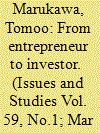| Srl | Item |
| 1 |
ID:
190969


|
|
|
|
|
| Summary/Abstract |
This study explores the nature and evolution of China’s developmental state through a detailed case study of the country’s semiconductor industrial policy. China, since the 1980s, can be described as an entrepreneurial developmental state due to its prioritizing of economic growth and use of direct investment in its industries. The country’s semiconductor industrial policy during the 1980s and 1990s fits neatly into this model due to the government’s focus on developing national champions. With the failure of these projects, however, the government was forced to adopt the policies of a general developmental state and use indirect incentives to promote the growth of its IC (integrated circuit) industry. Several hybrid and foreign firms began to develop as a result of these policies. The Chinese government launched a new industrial policy in 2014 to revitalize its IC industry, indicating a return to the entrepreneurial state model. China established National IC Funds which amassed huge sums of money from the state budget and state-owned enterprises (SOEs). Close scrutiny of the investments of these funds reveals that 54% was risked on two national champions while the rest was diversified among more than 300 firms when accounting for indirect investment through investment companies. This diversification is representative of the investor state model. The recent bankruptcy and ensuing scandals suggest that China’s entrepreneurial state suffers from serious deficiencies in its governance. This study concludes that the Chinese government should reconsider its development model and consider transforming itself into that of a more cautious investor state while improving its governance mechanisms.
|
|
|
|
|
|
|
|
|
|
|
|
|
|
|
|
| 2 |
ID:
124771


|
|
|
|
|
| Publication |
2013.
|
| Summary/Abstract |
While Japanese business interests support the export of high-technology items and the transfer of technology from Japan to China, these economically motivated actions may have direct and indirect impacts on Japan's national security. First, the transfer of dual-use technology to China may directly help China's military buildup. Second, high-tech exports and technology transfers may have an indirect effect by eroding Japan's technological advantages vis-à-vis China. In this article I place these concerns into a historical context and analyze the current challenges to Japan's export control policies. I offer an overview of the Japan- China trade relationship, with a special focus on high-tech trade. I then discuss changes in Japan's export controls regarding China, based on heightened security concerns. Evidence indicates that the Japanese government is ill equipped to deal with "technology leakage," which is accelerating the erosion of Japan's technological supremacy and is not covered by its current export control regime.
|
|
|
|
|
|
|
|
|
|
|
|
|
|
|
|
| 3 |
ID:
124667


|
|
|
|
|
| Publication |
2013.
|
| Summary/Abstract |
A symptom common to many industries in China is the proliferation of enterprises. Through a detailed case study based on original data of the automobile industry, it was found that dynamic entry and exit have been taking place. This industry's peculiar environment, in which even critical inputs such as engines and designs can be outsourced, is an important factor that induces rampant entry. Although there is significant economy of scale in the industry, many new entrants have succeeded in making profits by rapidly expanding their scale. Thus, it is incorrect to regard their entry behaviour as irrational. However, the Chinese government has contended that the current structure of its automobile industry is imbalanced and has tried unsuccessfully to consolidate it by encouraging the formation of industrial groups.
|
|
|
|
|
|
|
|
|
|
|
|
|
|
|
|